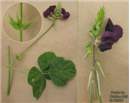Scientific name(s)
Macroptilium bracteatum
Strengths
- extremely palatable
- suitable on a wide range of soil textures with easy establishment on clay soils
- addresses soil fertility decline in cropping soils
- non-bloating
- regenerates well from seed each year
- greater tolerance of cool temperatures means it can establish and commence growth earlier in spring than other subtropical, tropical legumes
Limitations
- high palatability restricts use to ley pastures and short term phase pastures and requires appropriate grazing management
- has a specific rhizobium requirement
- susceptible to insect and virus damage
Plant description
Plant: erect or trailing, summer growing, perennial legume.
Stems: hairy, mostly fairly fine (1 - 2 mm diameter).
Leaves: comprise 3 leaflets; hairy on upper and lower surfaces.
Flowers: purple-red and are borne on stems about 15cm long with a ring of small leaf-like structures at the base.
Pods: 4 - 9 cm long, straight and cylindrical; with 9 to 17 seeds per pod.
Seeds: seeds mottled, brown, black and tan; 170,000 seeds/kg.
Pasture type and use
Used mainly as a short-term legume within cropping systems where the focus is on producing high quality forage and/or addressing fertility decline. It is well suited to the heavy soils of the cropping regions of southern Queensland and northern New South Wales.
Where it grows
Rainfall
Best suited to regions with 600 - 1200 mm annual rainfall with a predominantly summer rainfall distribution.
Soils
Wide range of soil types acceptable but best adapted to moderately heavy to heavy textured cropping soils.
Temperature
Will germinate and grow in temperatures lower than many other subtropical and tropical legumes. Tops killed by frost.
Establishment
Companion species
Grasses: buffel grass, green, Gatton and Bambatsi panics, Bisset creeping bluegrass, and Floren bluegrass.
Legumes: Milgarra butterfly pea and Primar and Unica caatinga stylo. When sown with these legumes, burgundy bean is usually less persistent.
Sowing/planting rates as single species
3 - 5 kg/ha, 5 - 8 kg/ha for coated seed.
Sowing/planting rates in mixtures
1-3 kg/ha, 2-5kg/ha for coated seed.
Sowing time
Can be sown in spring or summer depending on moisture availability.
Inoculation
Requires a specific inoculum, strain CB1717.
Fertiliser
Application of 10 - 20 kg/ha P (e.g. 100 - 200 kg/ha superphosphate) at sowing improves performance on old cropping soils. Molybdenum and sulphur may also be necessary in some situations.
Management
Maintenance fertliser
Mostly used on cropping soils and additional fertilizer not usually applied in short term pasture phases.
Grazing/cutting
Best rotationally grazed; under continuous grazing, stock concentrate on the palatable burgundy bean ultimately killing plants.
Seed production
Seed maturity is not uniform and the seed pods shatter easily. Seed production of up to 1 t/ha is attainable.
Ability to spread
Can spread within the paddock due to seed pod burst at maturity. High palatability however results in little spread outside of the sown area.
Weed potential
Potential is low for weediness due to high palatability at all stages of maturity and rapid breakdown of hard seed.
Major pests
No major pests, although seedlings can be affected by bean fly, and seed production by flower-eating caterpillars and green vegetable bugs.
Major diseases
No major disease problems. Bean mosaic virus symptoms can appear but has little effect on productivity.
Herbicide susceptibility
Spinnaker® (Imazethapyr) can be used as pre-sowing/pre-emergent, post-sowing/pre-emergent or post-emergent herbicide (first or second full leaf). Glyphosate can be used post-sowing/pre-emergent to control weeds at planting, and has also been used at low application rates on mature plants to control emerging weeds.
Animal production
Feeding value
Produces high quality feed, with crude protein levels around 20%, compared with those of lucerne of 22% and butterfly pea of 24.5%.
Palatability
Extremely palatable and selectively grazed.
Production potential
Burgundy bean can produce 5 - 8 t/ha of dry matter each year, with a first year production advantage over butterfly pea, caatinga stylo and lucerne.
Livestock disorders/toxicity
None recorded. Burgundy bean does not cause bloat.
Cultivars
Two cultivars, usually sold in a mixture.
| Cultivar | Seed source/Information |
| Cadarga | Guide to Australian Pasture LegumesHeritage Seeds |
| Juanita | Guide to Australian Pasture Legumes |
Further information
Tropical Forages database (SoFT) - Burgandy BeanBetter Pastures for the Tropics and Subtropics
Author and date
Stuart Brown & Bruce Pengelly (CSIRO Sustainable Ecosystems)
September 2007.





